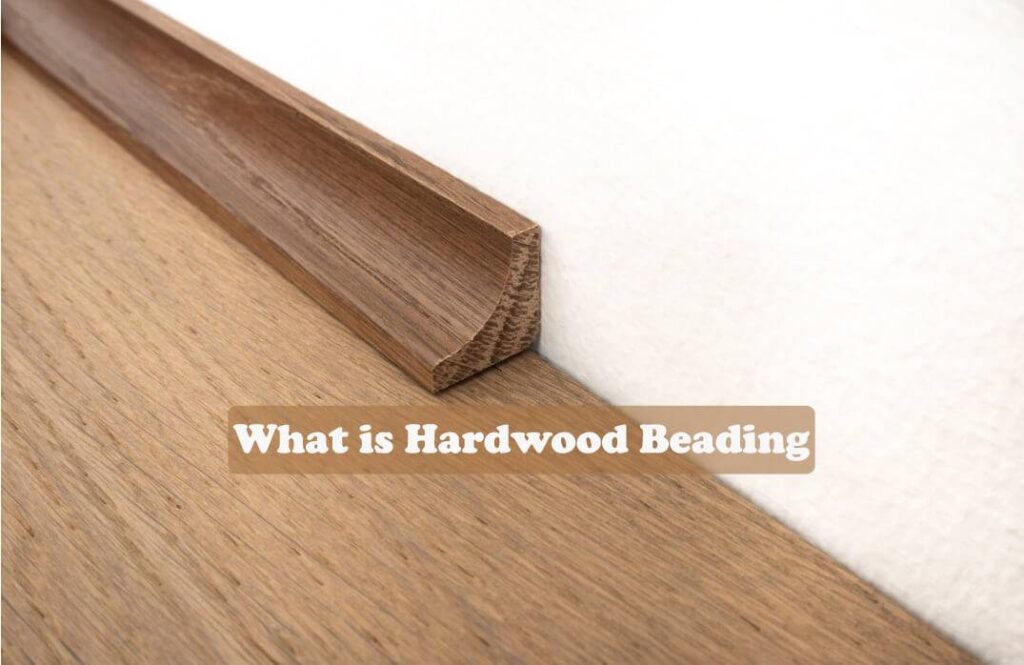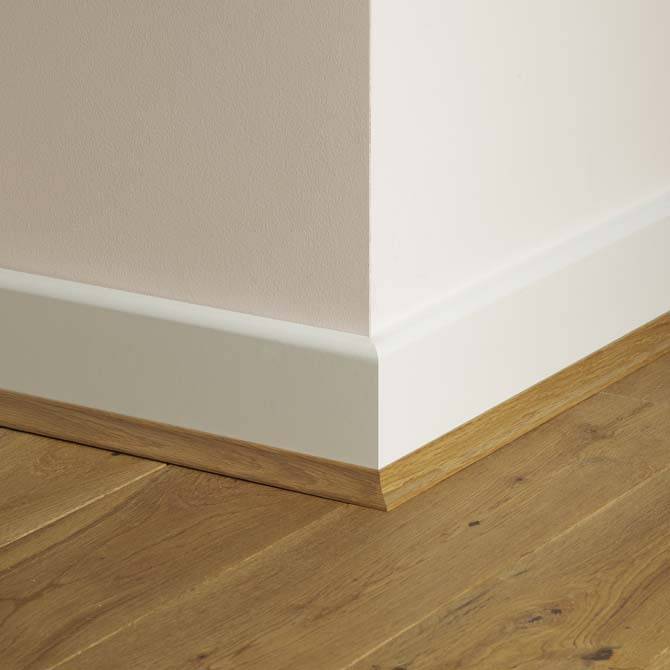Hardwood beading is a thin strip of hardwood used primarily to cover the expansion gap around the perimeter of a room with hardwood flooring.
Here’s a breakdown of its key aspects:
- Material: Made from hardwood, known for its durability and aesthetic appeal.
- Function: Primarily used to conceal the expansion gap, which is necessary for the natural expansion and contraction of hardwood floors due to temperature and humidity fluctuations.
- Application: Installed after the hardwood flooring and typically fits against existing skirting boards.
- Types: Two main types are scotia and quadrant, differing primarily in their profile shape.
While the primary purpose of hardwood beading is functional, it can also add a decorative touch to the finished look of the flooring.
What are the uses of hardwood beading?
The primary use of hardwood beading is to conceal the expansion gap left around the perimeter of a room during the installation of hardwood flooring. This gap is crucial as it allows the wood to naturally expand and contract with changes in temperature and humidity without buckling or warping.
However, while covering the gap is its main function, hardwood beading can also offer additional benefits:
- Aesthetics: Hardwood beading adds a finished and polished look to the flooring, particularly when matched to the existing skirting boards or the overall design theme of the room. It can also help create a smooth transition between the flooring and the wall.
- Protection: The beading can offer minor protection to the wall from kicks or bumps, especially in high-traffic areas.
- Cable concealment: In some cases, thin electrical cables might be discreetly run behind the beading, offering a more streamlined appearance compared to surface-mounted cables.
It’s important to note that hardwood beading is not a substitute for proper installation techniques or addressing underlying moisture issues that might cause excessive expansion and contraction of the flooring.
Scotia Beading: A Finishing Touch for Hardwood Floors
Scotia beading, a type of hardwood beading, plays a crucial role in the aesthetics and functionality of hardwood flooring installations.
Function:
- Concealing the Expansion Gap: Primarily, scotia beading covers the expansion gap left between the perimeter of the hardwood flooring and the wall. This gap is essential for the wood to naturally expand and contract with environmental changes, preventing warping and buckling.
- Hiding Imperfections: Scotia beading can also help conceal any minor imperfections that might occur at the junction between the flooring and the wall, creating a clean and finished look.
Benefits:
- Aesthetics: Scotia beading adds a decorative element to the flooring, framing the edges and creating a smooth transition between the floor and the wall.
- Choice and Customization: Available in various styles and finishes, including primed or pre-finished options, scotia beading can be chosen to complement the existing skirting boards and the overall design theme of the room.
- Material Versatility: While traditionally made from hardwood, scotia beading can also be found in MDF (Medium-density fibreboard) or PVC (Polyvinyl chloride), offering alternative options depending on budget and preference.
Installation:
Scotia beading is typically installed after the hardwood flooring is laid. It’s secured to the wall using nails, glue, or a combination of both, ensuring a firm and secure fit.
Considerations:
- Matching the beading profile: Choosing the correct profile for your existing skirting boards is crucial for a seamless transition.
- Pre-finished vs. Unfinished: Pre-finished options offer convenience, while unfinished options allow for greater customization through painting or staining.
- Moisture resistance: When choosing materials, consider opting for moisture-resistant options like PVC if the beading will be exposed to moisture in areas like bathrooms or kitchens.
In conclusion, scotia beading is a practical and aesthetic element in hardwood flooring installations. It offers both functional and decorative benefits, contributing to a polished and finished look while ensuring the longevity of the flooring.
Quadrant Beading: A Curved Finishing Touch for Floors
Quadrant beading, another type of hardwood beading, provides a distinctive finishing touch to hardwood floors with its curved profile.
Function:
Similar to scotia beading, the primary function of quadrant beading is to conceal the expansion gap between the hardwood flooring and the wall. This gap allows the wood to naturally expand and contract with environmental changes, preventing damage.
Benefits:
- Unique Aesthetics: Unlike scotia beading’s angled profile, quadrant beading features a smooth, curved design. This can add a softer and more elegant touch to the overall look of the flooring, particularly in rooms with curved features or traditional design styles.
- Seamless Transitions: The curved profile of quadrant beading can create a more seamless transition between the floor and the wall, especially when used with curved skirting boards or coving.
- Material Versatility: Similar to scotia beading, quadrant beading is available in various materials like hardwood, MDF, and PVC, offering options to suit different budgets and preferences.
Installation:
The installation process for quadrant beading is similar to scotia beading. It’s typically installed after the flooring is laid and secured to the wall using nails, glue, or a combination of both.
Considerations:
- Profile compatibility: Like scotia beading, it’s crucial to choose a quadrant beading profile that matches the existing skirting boards for a cohesive look.
- Pre-finished vs. Unfinished: Similar options exist for pre-finished and unfinished quadrant beading, allowing for convenience or customization based on your preference.
- Moisture resistance: Consider opting for moisture-resistant materials like PVC if the beading will be exposed to moisture in areas like bathrooms or kitchens.
In conclusion, quadrant beading offers a distinct and visually appealing option for finishing hardwood flooring. Its curved profile adds a unique aesthetic touch while providing the same functional benefits as scotia beading, ensuring the longevity and polished look of your flooring.
Frequently Asked Questions (FAQs) about Hardwood Beading
What is hardwood beading?
Hardwood beading is a thin strip of wood used primarily to cover the gap between the edge of your hardwood flooring and the wall. This gap is necessary to allow the wood to naturally expand and contract with changes in temperature and humidity.
What are the different types of hardwood beading?
The two main types of hardwood beading are:
- Scotia beading: This type has a right-angled profile, creating a sharp corner where the floor meets the wall.
- Quadrant beading: This type has a curved profile, offering a softer and more seamless transition between the floor and the wall.
What are the benefits of using hardwood beading?
- Conceals the expansion gap: This is the primary function of beading, preventing potential issues like warping or buckling of the flooring.
- Enhances aesthetics: Beading adds a finished and polished look to your flooring, especially when chosen to complement the existing skirting boards and overall design.
- Minor protection: The beading can offer some protection to the wall from kicks or bumps, particularly in high-traffic areas.
- Cable concealment: In some cases, thin electrical cables can be discreetly run behind the beading for a cleaner look.
What factors should I consider when choosing hardwood beading?
- Profile: Choose a profile (scotia or quadrant) that complements your existing skirting boards for a cohesive look.
- Material: Hardwood is traditional, but options like MDF and PVC offer affordability and moisture resistance in areas like bathrooms or kitchens.
- Finish: Pre-finished options offer convenience, while unfinished ones allow for customization through painting or staining.
Can I install hardwood beading myself?
While it’s possible to install beading yourself, some DIY experience is recommended. The process typically involves securing the beading to the wall using nails, glue, or a combination of both. If you’re unsure about your DIY skills, it’s always best to consult a professional installer.



